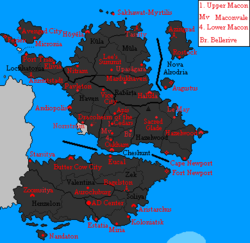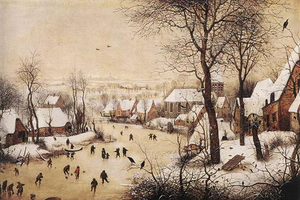Flaventia
| Dynastic Incarnation of the Lands of Flaventia | |||
| |||
| Motto: Facciamo la baia il nostro lago | |||

| |||
| Map versions | 6.7.7 - present | ||
| Capital | Anmutstadt and Tassity | ||
| Largest city | Hazelwood, Butter Cow City | ||
| Official language(s) | Natspeak, Zeigish, Neemian, Hazel, Laval, Alrodrian | ||
| Official religion(s) | Bovinism, Hazel druidism | ||
| Demonym | Flaventian | ||
| - Adjective | Flaventian | ||
| Government | Monarchy | ||
| - {{{headofstatetitle}}} | {{{headofstate}}} | ||
| - Faro | Nathan II | ||
| - Legislature | The Flaventian Quadricameral Legislature | ||
| Establishment | c.2004 (1493 AN) | ||
| - Ranked | {{{agerank}}} | ||
| Area | |||
| Population | 59,800,000 | ||
| Abbreviation | DILF | ||
Flaventia, officially the Dynastic Incarnation of the Lands of Flaventia is a demesne union of Natopia that occupies most of Yellow Island, the surrounding islands (except Augusta and Ptia) and part of the Laval Peninsula on Tapfer. It serves as the base of power for the Waffel-Paine family which controls the demesne's government. The demesnes of Ziegeland, Tas Neemia, Alrodey and Sororiya are currently united with Flaventia.
Geography
Yellow Island is dominated by a large mountain, Mount Vice. Ziegeland is characterized by low-lying countryside sloping down to the bay, with excellent conditions for cotton cultivation. Western and southern Ziegeland is the world's largest cotton producing area, containing 60% of the world's exportable surplus cotton fields. Eastern Ziegeland, historically the duchy of Hazelwood, is covered in dense forests. Tas Neemia, to the north, is mostly flat grasslands, ideal for cattle ranches. Beef, dairy, and butter, were important resources for early Neemites in the area and no doubt contributed to the rise of Bovinism there. The coast from Nitram to Hazelwood is mostly cliffs, which contributed to Natopian development favoring bayside growth. Large shoals and reefs south of Alrodey and around Augusta made navigation and settlement difficult in those areas.
The islands of Ferien and Micronia, serve as barrier islands to the entrance of Borders Bay, and are important naval and fishing ports, respectively.
Alrodey, situated on Crystal Island, is a rocky island with sheer cliffs on most of the coast line except around Ashington and Rostock. The island's economy is mostly dependent on mining and exporting gemstones.
Sororiya, on the northern coast of the Laval Pensinsula is a combination of bushland, farmland, and grasslands.
People
Flaventia is a cosmopolitan and diverse land. The people of Ziegeland, mainly descended from the ancient Mehl, Haas, and Andi tribes, are relatively conservative, industrious, pious, and traditional. They are a stronghold for Free Juice and Bagel Party votes, pro-monarchist, loyal and enthusiastic supporters of the Waffel-Paine dynasty, and almost exclusively members of the Dozan Bovic Church. Until Natopia expanded beyond Yellow Island, the people of Ziegeland defined the greater "Natopian culture." The Hazel people, in eastern Ziegeland, live mostly secluded lives in the Great Hazel Woods. They practice religious syncretism with their native druidism, natural magick, ancestor worship in conjunction with Bovinist cosmology.
The Neemite people, in the north, were a mostly nomadic cowherding people. Their ancient beliefs include reincarnation. A quasi-religious figure, The Dhury, is believed to be the same reincarnated soul of Taznim, the Bovic saint who received the 8 Law from the Butter Cow; Chow, the princess who resisted then allied with Nett Opaegh; Sundara, the consort of Emperor Naian; and finally Asara Sisu, the pious Empress-Martyr who fulfilled the reincarnation cycle by giving birth to a male for the first time 13 generations. It is believed that ancient Neemites may perhaps be descended from Karnali travelers, or another asiatic people from Keltia. Tassity, their largest city, grew as the only large port city in the north. Nearby Crystal Island was under Tas Neemia's control for many years, and Tassity became extremely wealthy by exporting Neemian beef and gems from Crystal Island.
Out of the Flaventian demesnes, Alrodey is the most remote and distinct. For most of its history it has been either overlooked or used for its resources. The island's mining industry, combined with insatiable demand from Tas Neemia, and the island's rugged terrain instilling a fierce individuality, lead to early organized labor on the island and a strong tradition of democracy not found in Ziegeland or Tas Neemia, where life is relatively easy and wealth is abundant. Because of the island's sparse native population, it has had waves of refugees come through over the years to take advantage of the land being a blank slate, beginning with the first Alrodrian refugees who fled the collapse of their kingdom on Caplona. The Greivar, including Tinker Sprocket, settled on this island to work in the gem mines after the collapse of the Natollonia mining colony. The present people of Alrodey continue the traditions of democracy and pro-labor.
The Sororiyan people are descended from the Lavalonians who lived in the former Lavalonian province of Klaasiya (approximately present day Vonzek excluding the Newport panhandle, and not to be confused with the similarly named demesne of Klaasiya). After the VUAS collapse, the Lavalonians in Klaasiya still saw their Natopian neighbor as Lavalon's "sister land," a romantic moniker applied to the close relationship between Natopia and Lavalon until Lavalon invalidated the Venerable Union of Aligned States and disappeared from Micras. These sympathetic Lavalonians called themselves Sororiyans, "sister landers," to show solidarity. Although loyal and supportive of their Ziegelandish neighbors to the north, Sororiyans have vastly different ideals inherited from their Lavalonian ancestors. The fertile farmlands of Sororiya have made these strong, stubborn, and resolute people quite different from their 'softer' Ziegeish neighbors. They are meritocrats, pragmatists, progressives, and religiously ambivalent. They tolerate the monarchial system imposed on them by Ziegeland because it was simply laid over their cherished university districts, which was then expanded to the rest of Flaventia in compensation. Great Sororiyan statesmen include Konrad von Zeck and Christo Eucalyptos.
Flaventian identity
Aside from the historic relation of these lands as the earliest territory of Natopia, these disparate groups of people are united almost exclusively due to the fact that inheritance, marriage, and birthright, brought all these lands under the control of the Waffel-Paine family in the person of Naian Waffel-Paine, who inherited Ziegeland from his father Nathan Waffel-Paine and Tas Neemia from his half-brother Nathaniel Ayreon-Kalirion. Alrodey was reclaimed by virtue of it being within Tas Neemia in the past, and the people of Sororiya gifted their land to Nathan II. Naian, as king of Ziegeland and raja of Tas Neemia, two very different cultures, began the process of promoting a unifying, single, Flaventian identity in addition to people's local ancestral identity. Naian was himself a product of Mehl and Hazel peoples. He took Sundara, a Neemite, as his consort and so their child Asara Waffel-Paine was a personification of Ziegeish and Tas Neemian unity. Asara's husband, Kyle Kilynn, was a Draconian, an often marginalized minority in Ziegeland. They descended from the anti-Natopians who opposed Nett Opaegh and have always carried the mark of distrust. Asara's union with Kyle, which produced two children Nathan II and Clara Waffel-Paine enhanced the public opinion of Draconians in Ziegeland.
Naian also chose a new symbol for this new amalgamation, the griffin. A blend of two powerful animals combined into something more powerful than its constituent parts. Importantly, the lion and the eagle were not symbols of Ziegeland or Tas Neemia, representing the creation of something new. The new crown of the Faro was modeled on the the Crown of Princess Chow Dhury, with a Ziegeish red velvet cap, and petrified Hazel woodstones. He was the first to formalize the house laws of the Waffel-Paine family and integrated that dynasty into the laws and institutions of Flaventia, giving him and his direct descendants a solid base of devoted supporters from which to rule the wider empire.
Nobility
The Faro of Flaventia often creates counties (in Ziegeland and Sororiya) and subahs (in Tas Neemia) as gifts for important citizens. At times when the Faro and Natopian Emperor are the same person, these counties are also given to foreign dignitaries.
- Nathan II, Duke of Lochhatonia, Count of Elivia
- Ayeonr IV, Duke of Cheshunt, Count of Upper Macon, Count of Anmutstadt
- Lyr Angus-Moonoak, Duke of Haven, Count of Andiopolis
- Clara Sundara, Duchess of Hazelwood, Countess of Maconvale, Begum of Tassity
- Janus Eadric, Duke of Valentina
- Francis Joseph IV, Count of Le May
- Gwyn, Count of Bellerive
- The Current Kaiser of Shireroth, Count of Dracoheim
- Aldin and Li, Count and Countess of Macon Rapids
- Ivo, Count of Pavleton
- Mira Octavius-Aryani, Begum of Sakhawat-Myrtilis
- Isabella Kalirion, Countess of Apis
- David Raion, Count of Lower Macon
| |||||||||||||||||||||||||||||||||||||



